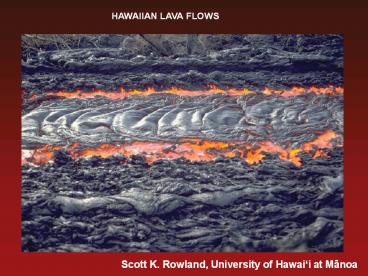HAWAIIAN LAVA FLOWS - PowerPoint PPT Presentation
1 / 58
Title:
HAWAIIAN LAVA FLOWS
Description:
HAWAIIAN LAVA FLOWS – PowerPoint PPT presentation
Number of Views:272
Avg rating:3.0/5.0
Title: HAWAIIAN LAVA FLOWS
1
HAWAIIAN LAVA FLOWS
2
From Hawaiian Dictionary by M.K. Pukui S.H.
Elbert
3
(Courtesy of Ululani Makue)
4
-low volumetric flow rate (lt10 m3 s-1) -low
flow-front velocity (1-10 m hr-1) -develops
lava tubes -innumerable flow units -thin (10-100
cm) flow units -lower viscosity -lower yield
strength -slightly hotter -helluhraun (pavement
lava) in Icelandic
-high volumetric flow rate (10-103 m3
s-1) -high flow-front velocity (102-104 m
hr-1) -develops large channels -few, large flow
units -thick (1-10 m) flow units -higher
viscosity -higher yield strength -slightly
cooler -apaluhraun (rough lava) in Icelandic
5
3 m
6
Wave-cut cliff section, Makapuu, Oahu
7
(No Transcript)
8
For every lava rheology, there is a critical
disruption rate beyond which it cannot flow as a
fluid
Qualitative graph after Peterson Tilling (1980)
and Kilburn (1981)
9
(No Transcript)
10
(No Transcript)
11
When moving, the incandescent interior is deforms
fluidly
1 m
12
The top surface consists of relatively small,
spiny clinkers
13
standard geologists for scale
14
(No Transcript)
15
(No Transcript)
16
5 m
17
A big, fast-moving channel (1984 Mauna Loa
eruption)
10 m
flow direction
18
Channels develop downflow, from distinct near the
vent to indistinct (or non-existent) at the flow
front.
flow front
flow direction
stable channel
Lipman Banks (1987)
19
A velocity gradient sets up relative rotation and
shear, tearing viscous lumps of surface and
near-surface lava into ragged clinkers.
20
Air photo of the distal end of the 1942 Mauna Loa
flow
21
Transition of distinct channel to zone of
dispersed flow
4 m
flow direction
22
flow cores
clinker
23
Accretionary lava balls
1.5 m diameter
24
(No Transcript)
25
0.5 m
26
2 m
27
40 cm
28
20 cm
29
(No Transcript)
30
Inflated flows exposed at the coastline of Pinta,
Galápagos
pelican for scale
31
(No Transcript)
32
(No Transcript)
33
(No Transcript)
34
Multiple generations of ropes
35
Side view into an active lava tube
36
a 1 m x 2 m skylight in the roof of an active
tube
37
Master lava tubes can be many meters high and
wide. Note that during a tube-fed eruption, the
main tube is essentially as long as the flow,
(the distance from vent to flow- front), but
afterwards it almost never drains completely.
38
Like a large channel, a large tube develops
downflow
(same time, different locations along the flow)
39
One mechanism of tube formation is coalescence of
many small, single flow-unit tubes (i.e., toes)
into a master tube.
(same location, different times)
40
Another tube-formation mechanism is roofing of a
lava channel. Here, the surface skin is growing
in a down-flow direction.
flow direction
1 m
41
Here, a surface skin growing inward from the
channel margins
1 m
42
(No Transcript)
43
Sources of blue fume mark the line of an active
tube
44
Tumulus on 1859 Mauna Loa flow, on the coastal
plain
George Walker for scale
45
Tumulus on an old Mauna Loa SW rift zone
flow, Puu Hou (1868 littoral cone) in background
46
A leaky tumulus
2 m
47
(No Transcript)
48
(No Transcript)
49
10 cm
50
(No Transcript)
51
s
p
p
p
s
s
52
(No Transcript)
53
Water inhibits formation of this secondary
coating -it does not form near water- retaining
fractures -it does not form where rain drips
from plants -shading of sunlight is also involved
54
(No Transcript)
55
Lava trees (2 m high)
56
A forest of lava trees, partially buried by scoria
57
(No Transcript)
58
PAU































